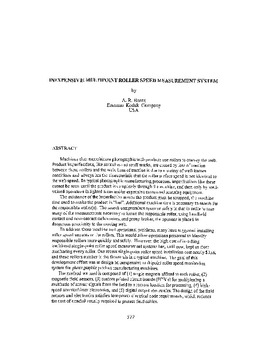| dc.contributor.author | Bentz, A. R. | |
| dc.contributor.other | International Conference on Web Handling (1997) | |
| dc.date.accessioned | 2019-11-05T18:28:44Z | |
| dc.date.available | 2019-11-05T18:28:44Z | |
| dc.date.issued | 1997-06 | |
| dc.identifier | oksd_icwh_1997_bentz | |
| dc.identifier.citation | Bentz, A. R. (1997, June). Inexpensive multipoint roller speed measurement system. Paper presented at the Fourth International Conference on Web Handling (IWEB), Stillwater, OK. | |
| dc.identifier.uri | https://hdl.handle.net/11244/321727 | |
| dc.description.abstract | Machines that manufacture photographic web products use rollers to convey the web. Product imperfections, like scratches and scuff marks, are caused by loss of traction between these rollers and the web. Loss of traction is due to a variety of well-known conditions and always has the characteristic that the roller surface speed is not identical to the web speed. In typical photographic manufacturing processes, imperfections like these cannot be seen until the product is completely through the machine, and then only by well-trained operators in lighted areas and/or expensive automated scanning equipment. | |
| dc.description.abstract | The existence of the imperfection means the product must be scrapped; the machine time used to make the product is "lost". Additional machine time is necessary to search for the responsible roller(s). The search compromises operator safety in that in order to take many of the measurements necessary to locate the responsible roller, using handheld contact and non-contact tachometers, and prony brakes, the operator is placed in dangerous proximity to the moving web. | |
| dc.description.abstract | To address these machine and operational problems, many have suggested installing roller speed sensors on the rollers. This would allow operations personnel to identify responsible rollers more quickly and safely. However, the high cost of installing traditional single-point roller speed measurement systems has, until now, kept us from monitoring every roller. One recent single-point roller speed installation cost nearly $25K and these rollers number in the thousands in a typical machine. The goal of this development effort was to design an inexpensive multipoint roller speed monitoring system for photographic product manufacturing machines. | |
| dc.description.abstract | The method we used is composed of (1) single magnets affixed to each roller, (2) magnetic field sensors, (3) custom printed circuit boards (PCB' s) for multiplexing a multitude of sensor signals from the field to a remote location for processing, (4) high-speed counter/timer electronics, and (5) digital output electronics. The design of the field sensors and electronics satisfies low-power electrical code requirements, which reduces the cost of conduit usually required to protect field cables. | |
| dc.description.abstract | The final costs were roughly $100K for an installation of about 450 sensors ($220/point) after initial development and design. That cost did not include the control computer or programming. | |
| dc.format | application/pdf | |
| dc.language | en_US | |
| dc.publisher | Oklahoma State University | |
| dc.rights | In the Oklahoma State University Library's institutional repository this paper is made available through the open access principles and the terms of agreement/consent between the author(s) and the publisher. The permission policy on the use, reproduction or distribution of the article falls under fair use for educational, scholarship, and research purposes. Contact Digital Resources and Discovery Services at lib-dls@okstate.edu or 405-744-9161 for further information. | |
| dc.title | Inexpensive multipoint roller speed measurement system | |
| osu.filename | oksd_icwh_1997_bentz.pdf | |
| dc.type.genre | Conference proceedings | |
| dc.type.material | Text | |
